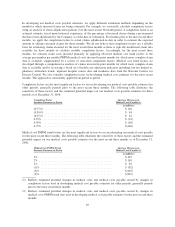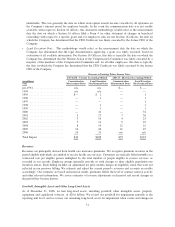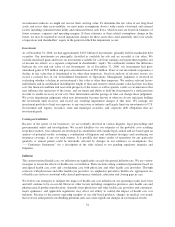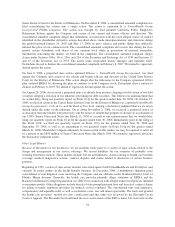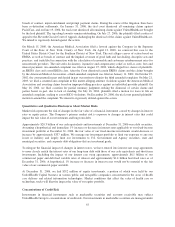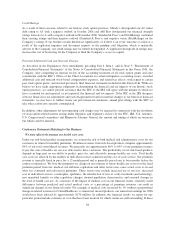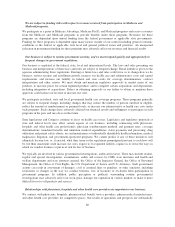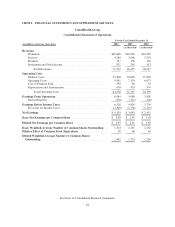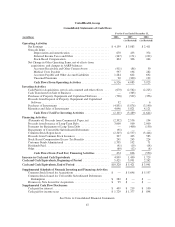United Healthcare 2006 Annual Report Download - page 61
Download and view the complete annual report
Please find page 61 of the 2006 United Healthcare annual report below. You can navigate through the pages in the report by either clicking on the pages listed below, or by using the keyword search tool below to find specific information within the annual report.estimates prove too high or too low, the effect of the change in estimate will be included in future results. That
change can be either positive or negative to our results.
We face competition in many of our markets and customers have flexibility in moving between competitors.
Our businesses compete throughout the United States and face competition in all of the geographic markets in
which they operate. For our Uniprise and Health Care Services segments, competitors include Aetna Inc., Cigna
Corporation, Coventry Health Care, Inc., Humana Inc., Kaiser Permanente and WellPoint, Inc., numerous
for-profit organizations and not-for-profit organizations operating under licenses from the Blue Cross and Blue
Shield Association and enterprises that serve more limited geographic areas. Our Specialized Care Services and
Ingenix segments also compete with a number of businesses. The addition of new competitors can occur
relatively easily, and customers enjoy significant flexibility in moving between competitors. In particular
markets, competitors may have capabilities or resources that give them a competitive advantage. Greater market
share, established reputation, superior supplier or provider arrangements, existing business relationships, and
other factors all can provide a competitive advantage to our businesses or to their competitors. In addition,
significant merger and acquisition activity has occurred in the industries in which we operate, both as to our
competitors and suppliers in these industries. Consolidation may make it more difficult for us to retain or
increase customers, to improve the terms on which we do business with our suppliers, or to maintain or advance
profitability.
Our relationship with AARP is important.
Under a ten-year contract with AARP, which commenced in 1998, we provide Medicare Supplement insurance,
hospital indemnity insurance, health insurance focused on those ages 50 to 64 and other products to AARP
members. As of December 31, 2006, this Supplemental Health Insurance program represented approximately
$5.0 billion in annual net premium revenue from approximately 3.8 million AARP members. We also have a
separate license agreement with AARP to brand certain of our Medicare Part D prescription drug plans. The
AARP contracts may be terminated by us or AARP at the end of their respective initial terms and may also be
terminated early under certain circumstances, including a material breach by either party, insolvency of either
party, a material adverse change in the financial condition of either party, and by mutual agreement. The success
of our AARP arrangements depends, in part, on our ability to service AARP and its members, develop additional
products and services, price the products and services competitively, and respond effectively to federal and state
regulatory changes.
Some of the effects of changes in Medicare remain uncertain.
The changes in Medicare as a result of the Medicare Modernization Act of 2003 (MMA) and the rules and
regulations promulgated thereunder are complex and wide-ranging and continue to affect our businesses. We
have taken advantage of new opportunities created by the MMA to partner with the federal government,
including Medicare Part D prescription drug coverage, Medicare Advantage Regional PPOs, Private Fee for
Service Plans and Special Needs Plans for chronically ill Medicare beneficiaries. We have invested considerable
resources in creating new Medicare product offerings for these initiatives and in analyzing how to best address
uncertainties and risks associated with these new programs and other changes arising from the MMA. Legislative
or regulatory changes to these programs could have a significant impact on us. Additionally, our ability to
successfully participate in the Medicare Part D program depends in part on coordination of information and
information systems between us, CMS and state governments. The inability to receive correct information due to
systems issues by the federal government, the applicable state government or us could adversely affect our
business. Additionally, our participation in the Medicare Part D program is based upon certain assumptions
regarding enrollment, utilization, pharmaceutical costs and other factors. In the event any of these assumptions
are materially incorrect, either as a result of unforeseen changes to the Medicare Part D program or otherwise,
our results could be materially affected. Any positive or negative developments for the Medicare Part D program
as a whole are likely to have a significant impact on us as a result of the size of our enrollment in our Medicare
Part D program.
59


